What is Strategic Planning?
Strategic planning is the process by which organizations make and materialize their mission. As you know, businesses need to analyze and understand their goals and internal processes. That’s where the best strategic plans come in.
If you want to identify your organization’s objectives, you need strong strategic planning.
If you want a roadmap for how your organization’s objectives should be achieved, you need strong strategic planning.

What is NOT Strategic Planning?
There might be more planning types than cells on a spreadsheet. Strategic planning. Business planning. Operational planning. How much planning do you need? Although they’re not quite strategic planning, we’re outlining a couple of planning processes here that often overlap. These provide slightly different solutions for approaching the various angles of your organization’s problems.
Business planning outlines your business’s current function, ownership and structure. This type of planning can be used to obtain funding. It can also be used as part of the first two stages of your organization’s overall strategic planning process.
Operational planning is the process of forming and actioning individual projects. It is often a sub-process needed to achieve your overall strategic planning agenda.
Why is Strategic Planning Important?
Success is 20 percent skills and 80 percent strategy. You might know how to read, but more importantly,what’s your plan to read?
Business leaders crave first-rate strategic planning.
Successful strategic planning puts organizations in the best positions to accomplish their agendas and capitalize on opportunities. When done with best practices, strategic planning coordinates management levels behind a clear aim, incentivizes creativity and promotes harmony among project ideas.
The Five Steps of the Strategic Planning Process
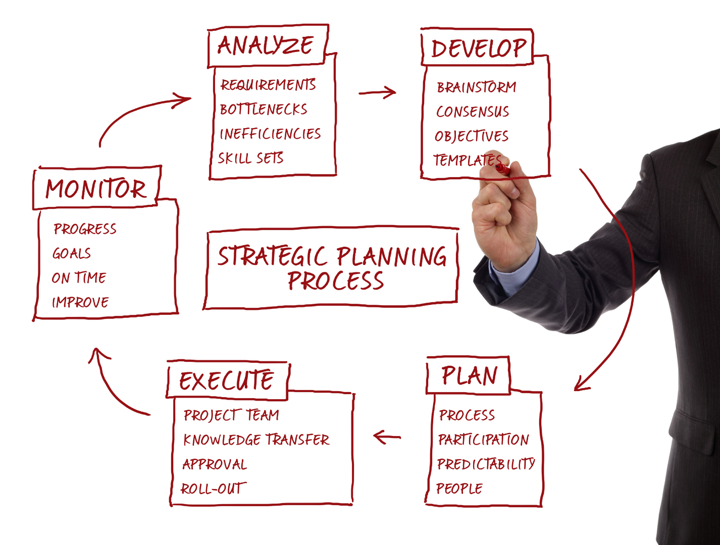
- Set Goals and Vision
Define your vision. Keep objectives clear and relevant across all levels of your organization.
Ask:
– What value do you want to bring to your users?
– What do your organization’s goals look like? Are they large-scale, long-term or tangible?
– How you will be able to measure if your firm’s vision is still relevant and viable?
- Conduct Analysis
Now that you have a targeted mission, you need an accurate perception of how your business interacts with both your immediate industry and related industries. In other words, now you need to use the best strategic planning tools. At this point of the process, leading strategic planners form accurate representations of their organization’s current and future business environments by engaging in industry analysis.
This is the most important step. Too many organizations miscalculate their strategy and focus on the wrong areas because they don’t conduct industry analysis.
Ask:
– What is your business? How does it currently operate?
– What emerging industries are important?
– What assumptions are you currently making about your business environment and its future trends?
– What assumptions can you safely make? What market research methods should you use? Who can help?
- Design Projects
The stage of the strategic planning process most unique to your specific business is deciding how to mobilize your resources to achieve your vision (operational planning). This is because every organization is different. For example, strategic planning in healthcare needs to involve different operational plans compared with small and medium-sized businesses.
However, some things never change. All strategic plans should involve projects designed to improve communication and collaboration, to enhance operational efficiency and to capitalize on or create future opportunities. Make a strategy map. At this point, you must work with team leaders to organize and align projects, resources, personnel and timing under your unified vision. Don’t forget to design key metrics by which to measure the success of your strategic plan.
Ask:
– Have all relevant team managers been given clear instructions?
– How will you measure if these projects support your strategic planning agenda?
– What projects would you prioritize if key industry circumstances change?
– Does everybody agree with the benefits of your proposals?
- Take Action
Okay, it’s time we set this thing in motion.
Strategic planning is at its best when organizations work together and commit to their action plans, rejecting the comfort of the status quo. Communication is the key to success. Upper management needs to enforce changes to team priorities. This can be achieved through altering and clarifying specific targets and shifting your organization’s resource allocation. Make sure the team supports each other towards their goals and ensure all team members are held accountable.
Ask:
– Are you following through? Are you advancing your agenda?
– Are you disrupting your core business model?
– Do you need to train your team for new projects?
– What steps will you take to implement your long-term strategic plans?
- Monitor and Adjust
You must check the performance of your strategic planning model. You must adapt based on the outcomes of your strategic plan. These are golden strategic planning best practices. One of the best strategic planning skills is to identify the most important strategic measures and use the feedback from these to adjust the plan. Get comfortable with changing the plan.
The strategic planning process should be considered circular. You should thoroughly examine your strategic plan annually unless your business is dynamic. In that case, monitor and adjust more frequently.
Ask:
– What needs adjusting: the processes or the measurement metrics?
– Is there a better vision that the company should be focused on?
– Have external industries changed?
– Is everything being communicated properly among key members of your organization?
Types of Strategic Planning Models

Now that you know how to make a strategic plan, you need to be familiar with the most popular strategic planning models. The following are some of the most important strategic planning templates. Which one will you choose?
- Basic Model – Best for small or inexperienced organizations
If you were considering operating without a strategic plan, forget it!
- Set your main mission
- Develop your goals and assign responsibilities
- Create a simple monitoring plan
This model is the minimum requirement for successful organizations. It’s a fantastic entry point into strategic planning for small businesses, such as those in the restaurant and food services industries. Start-ups, emerging industries and other cash-tight service industries should use this model for their first strategic plan. Small businesses might find it useful to base their goals on state-level analysis.
- Issue-Based Model (Goal-Based Model) – Best for organizations wanting an in-depth plan
How can your strategic planning process be formalized even further?
- Create a blueprint for a cyclical, structured strategic planning timeline
- Collaborate within your organization to form a clear unified vision
- Conduct internal, external, present and future analyses using key frameworks
- Develop operational plans
- Prioritize resources for the most important issues
- Maintain consistent evaluation through Key Performance Indicators (KPIs), industry analysis and manager meetings
- Adjust your strategic planning agenda following important feedback
This model is the most structured strategic planning approach. Established companies and industries in areas such as finance, manufacturing, mining and even long-standing small businesses should get familiar with this model. For example, this model is used in strategic planning in healthcare to optimize processes and align the organization’s action plans with its vital missions.
- Alignment Model (Gap Planning) – Best for organizations not yet going where they want
What are you missing?
- Evaluate your measurement metrics and criteria
- Conduct in-depth analyses of your business and its environment
- Communicate with managers and uncover potential issues
- Restate or adjust your vision
- Develop new action plans
- Implement the new action plans
- Closely monitor the new action plans
There are known knowns; these are things we know that we know.
There are known unknowns; that is to say, there are things that we know we don’t know.
But there are also unknown unknowns; there are things we don’t know we don’t know.
Organizations often need strategic planning skills related to this specific model. Discovering and explaining the gaps between performance and targets can help save failing organizations. This model can also help identify areas for improvement in already successful organizations. It can be used, for example, to identify necessary adjustments for food manufacturing companies to meet their regulatory requirements.
Gap analysis can also be used across the finance world, like when companies are looking for gaps in their operating balance sheets. It can help to align your business operations with your mission statement.
- Real-Time Model – Best for organizations in fast-paced environments
Strategic planning is a structured and firm process. Until it isn’t.
- Create a shared vision, with an outline of how to organically adapt the direction taken
- Conduct discussion and analysis openly and often
- Actively seek to identify what is changing within your environment and monitor how it changes
- Frequently change and adjust plans to find your competitive advantage
Many operational plans need to be short-term, especially in rapidly changing industries, such as energy, media or technical engineering. You need to proactively set up teams and processes to be able to react to sudden changes. Learn and teach the new skills required for the varying processes your organization will need to adopt. Less structure doesn’t mean less accountability.
Best Strategic Planning Frameworks
Strategic planning best practices are important. The following key strategic planning frameworks are the best tools you can use and, in many cases, are downright essential. In fact, most of these frameworks complement each other so well that it is vital to use them together!
Arguably, this framework is the most helpful when structuring a strategic plan. A balanced scorecard is extremely well suited for creating a strategy map. This approach analyzes four key elements (or perspectives) of a holistic business environment:
- Financial performance
- Stakeholders and customers
- Internal business processes
- Learning and Growth
Airline companies, for example, need a rounded strategic planning process that treats all business strategy elements as important. To best support their company from a financial perspective, airlines’ strategic plans need to both improve financial performance and optimize resource allocation. To best enhance their customer perspective, airlines need to increase consumer value and satisfaction. To improve their organization as a whole, it is important that airlines improve their quality controls and process efficiencies. Finally, to best support their business growth, airlines must invest back in their business through technology and labor-skills initiatives.
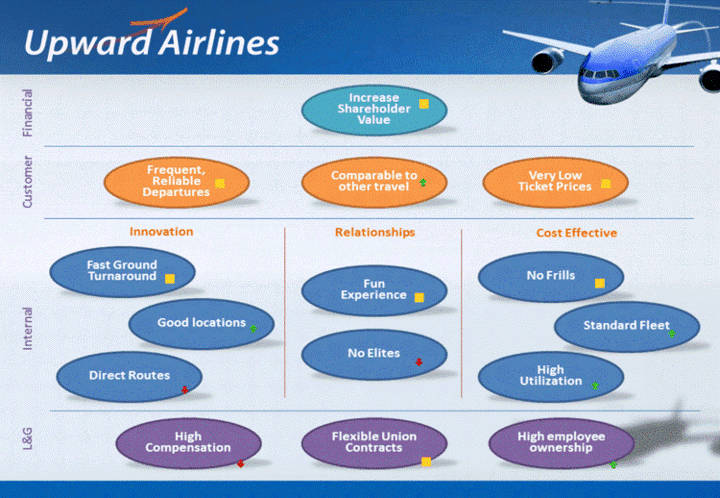
This strategic map example addresses all of the key perspectives. Project status icons can keep track of each project’s performance. For example, here the colored arrows and icons represent the direction of each project’s performance, where the green ‘up’ arrow represents improvement. (Read it from the bottom up).
Benchmarking ensures that your strategic plans stay grounded. This framework compares key performance metrics and business processes with competitors and industry best practices. It is very useful for discovering gaps in your own strategic plans as well as for identifying further opportunities.
A strategic plan for a call center, for example, will generally involve competitive benchmarking. They do this by gathering data from within their own business and comparing it with either direct competitors or call centers in other industries. This process will identify key gaps in the call center’s performance, such as in sales conversion rates. It can also help to identify differences in their competitors’ key internal processes and business model structures. Based on these gaps and differences, the call center can inform their own strategic planning model creation.
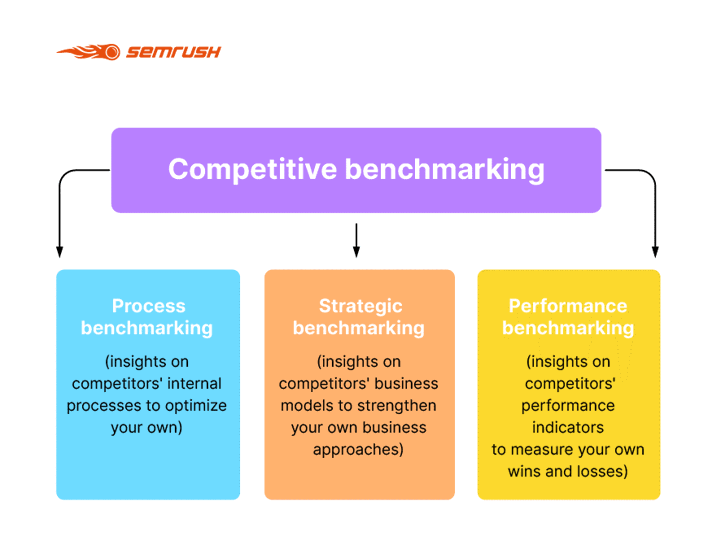
- Objectives and Key Results (OKRs)
The OKRs framework strengthens the goal-setting process of strategic planning. An OKR approach can simplify your organization’s strategic plan by highlighting key objectives and identifying effective, realistic and responsible key result measurements. Objectives tend to be long-term, however, you can adjust your key results to adapt to changing business environments or according to feedback from your process evaluations.
OKRs are useful in industries that have easily measurable KPIs. This includes retail, consulting and manufacturing industries. If you can automate the tracking of your key results, OKRs can be implemented and operated around at a relatively low cost. This strategic planning framework is especially useful for start-ups and organizations in rapidly-changing industries.
Other Strategic Planning Frameworks
Use this framework to analyze industries. It breaks down information to focus on five major forces:
- Threat of potential new entrants
- Threat of substitute goods/services
- Rivalry among existing competitors
- Bargaining power of suppliers
- Bargaining power of buyers
Use this framework in every strategic plan unless you have a good reason not to. The four elements encourage strategic planning approaches from both internal and external angles, for the past, the present and the future:
- Strengths
- Weaknesses
- Opportunities
- Threats
This framework is important for gaining a solid understanding of surrounding industries and external factors that can affect your strategic plan. Analyzing these external elements allows you to prioritize projects and find opportunities:
- Political
- Economic
- Social
- Technological
- Environmental
- Legal
- Ethical
Who is Important in Strategic Planning?
For an approach to be successful, all team members must align under a clear strategic planning agenda. It’s best if there is a designated planning team headed by a Chief Strategy Officer or Strategy Director. The organization’s Executive team needs to be informed and empowered to make decisions. Make sure you don’t forget the often-vital input from lower-level managers.
Importantly, external experts with unbiased opinions can help you avoid many of the common strategic planning traps. Industry analysts, for example, can identify clear business environment conclusions and support organizations in their analysis. Generally, strategic planning consultants lead businesses through the best courses of action. Strategic advisors can specialize in a range of areas, so it is important to identify what problems you need expert help with. Working with key advisors can optimize the allocation of your financial resources, identify major blind spots and give you an edge over your competitors.
Strong communication channels make strong strategic plans.
Common Strategic Planning Do’s and Don’ts
- Don’t disregard strategic planning, even if you are short on time and resources
- Do learn to let go. Some plans just don’t work. Bad timing, mistakes and even bad luck are all part of the strategic planning process
- Don’t make your feedback metrics too complicated. It can be hard to prioritize incoming information and can become too easy to justify bad plans
- Do make sure the resources are available or the procurement of resources is underway for future action plans
- Don’t let short-term budget goals exclusively dictate your operational plans or get in the way of your long-term vision
- Do learn to feel comfortable with the unknown. Don’t over-analyze future forecasts. Being too comfortable with how your strategic plan will unfold is a sign of bad strategic planning
- Don’t ignore short-term budget goals
- Do ensure your team is adhering to the timeframes of the strategic planning agenda
- Don’t lose sight of the importance of a client-focused, value-adding perspective when designing your projects
- Beware! Sometimes the best change is no change at all. Don’t get caught up in changing for the sake of change and be wary of ambitious pet projects that aren’t important to your business overall
Two Strategic Planning Examples
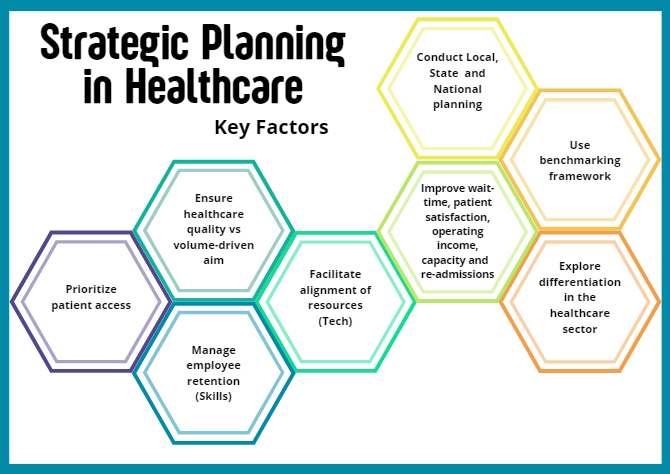
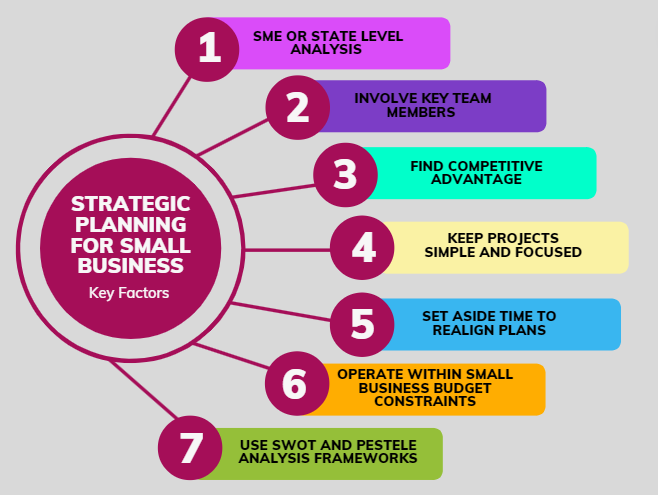
Source from Ibisworld
Disclaimer: The information set forth above is provided by Ibisworld independently of Alibaba.com. Alibaba.com makes no representation and warranties as to the quality and reliability of the seller and products.




